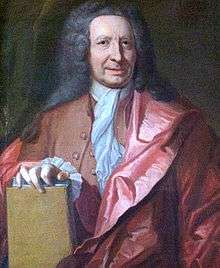Olof Rudbeck the Younger

Olof Rudbeck the Younger or Olaus Rudbeckius junior (15 March 1660, Uppsala – 23 March 1740) was a Swedish explorer, scientist, and the son of Olaus Rudbeck Sr. He succeeded his father as professor of medicine at Uppsala University. Serving aside Lars Roberg, he specialized in anatomy, botany, zoology, and pharmacology, while Roberg gave lectures in medicine, surgery, physiology, and chemistry.[1]
Young Rudbeck was an able botanist and ornithologist who took his doctor's degree in Utrecht in 1690. He traveled to Lapland in 1695, joining an expedition commissioned by the King, for which his mission was to study nature, the mountains in particular. He returned with an album of beautifully colored pictures of birds, flowers and scenery, for which he is best remembered.
At the beginning of the eighteenth century, Rudbeck Jr. turned his attention away from nature studies to speculation about the relationship between Sami and Hebrew languages. To honor his accomplishments (and posthumously, those of his namesake father) he was ennobled in 1719 by Queen Ulrika Eleanora as a "naturalized nobleman" (noble family of Rudbeck, nr. 1637). His student, the botanist Carl Linnaeus (1707–1778), named a genus of flowers Rudbeckia in honor of him and his father.
Rudbeck had 24 children with three wives.[1] His sister, Wendela, married Peter Olai Nobelius, and from them descends the Nobel family, including Ludvig Nobel, founder of Branobel and Alfred Nobel, founder of the Nobel Prizes.